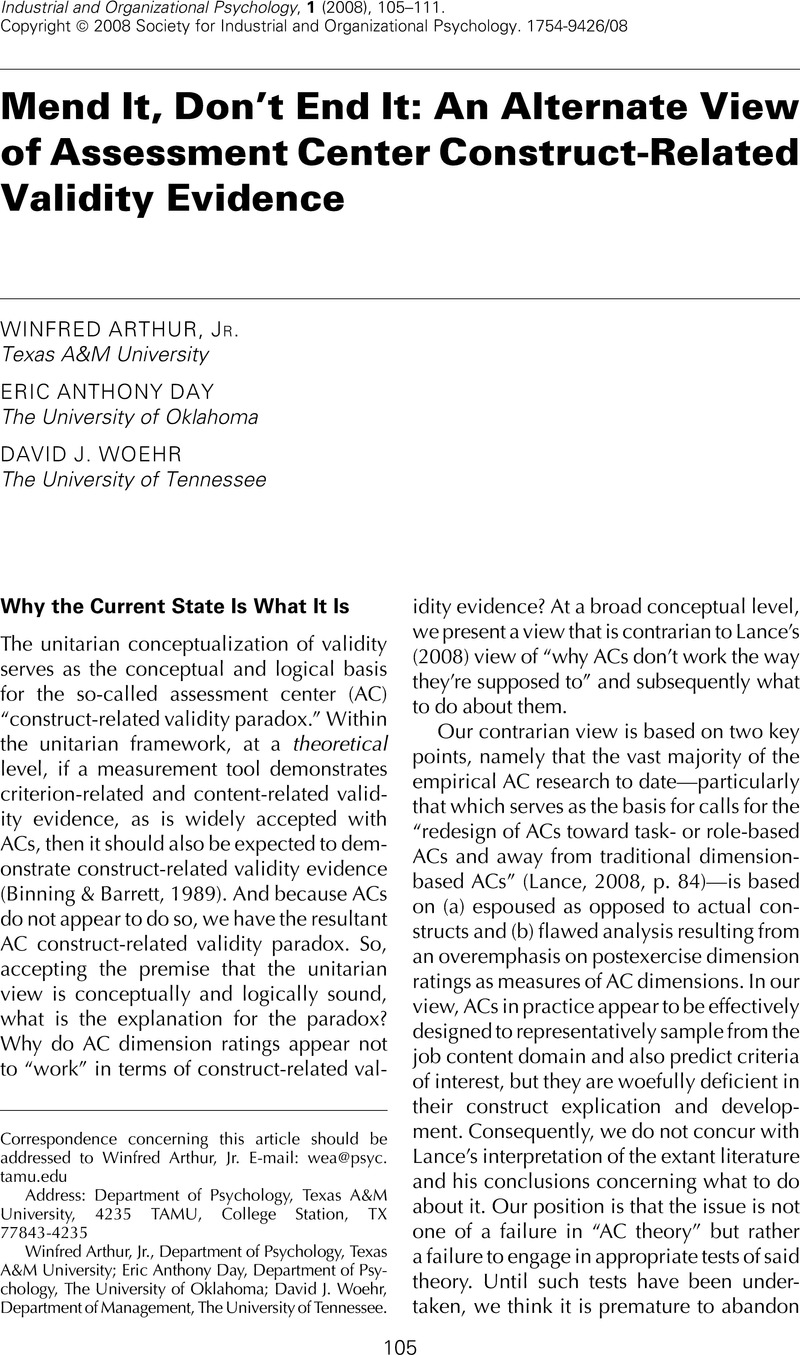Crossref Citations
This article has been cited by the following publications. This list is generated based on data provided by Crossref.
Lance, Charles E.
2008.
Where Have We Been, How Did We Get There, and Where Shall We Go?.
Industrial and Organizational Psychology,
Vol. 1,
Issue. 1,
p.
140.
HOFFMAN, BRIAN J.
and
WOEHR, DAVID J.
2009.
DISENTANGLING THE MEANING OF MULTISOURCE PERFORMANCE RATING SOURCE AND DIMENSION FACTORS.
Personnel Psychology,
Vol. 62,
Issue. 4,
p.
735.
Thornton, George C.
and
Gibbons, Alyssa M.
2009.
Validity of assessment centers for personnel selection.
Human Resource Management Review,
Vol. 19,
Issue. 3,
p.
169.
Lievens, Filip
Dilchert, Stephan
and
Ones, Deniz S.
2009.
The Importance of Exercise and Dimension Factors in Assessment Centers: Simultaneous Examinations of Construct-Related and Criterion-Related Validity.
Human Performance,
Vol. 22,
Issue. 5,
p.
375.
Highhouse, Scott
2009.
Tests Don't Measure Jobs: The Meaning of Content Validation.
Industrial and Organizational Psychology,
Vol. 2,
Issue. 4,
p.
493.
Jackson, Duncan J. R.
Stillman, Jennifer A.
and
Englert, Paul
2010.
Task‐Based Assessment Centers: Empirical support for a systems model.
International Journal of Selection and Assessment,
Vol. 18,
Issue. 2,
p.
141.
HOFFMAN, BRIAN J.
MELCHERS, KLAUS G.
BLAIR, CARRIE A.
KLEINMANN, MARTIN
and
LADD, ROBERT T.
2011.
EXERCISES AND DIMENSIONS ARE THE CURRENCY OF ASSESSMENT CENTERS.
Personnel Psychology,
Vol. 64,
Issue. 2,
p.
351.
Silzer, Rob
and
Jeanneret, Richard
2011.
Individual Psychological Assessment: A Practice and Science in Search of Common Ground.
Industrial and Organizational Psychology,
Vol. 4,
Issue. 3,
p.
270.
Jansen, Anne
Lievens, Filip
and
Kleinmann, Martin
2011.
Do Individual Differences in Perceiving Situational Demands Moderate the Relationship Between Personality and Assessment Center Dimension Ratings?.
Human Performance,
Vol. 24,
Issue. 3,
p.
231.
Hoffman, Brian J.
and
Meade, Adam
2012.
Alternate Approaches to Understanding the Psychometric Properties of Assessment Centers: An analysis of the structure and equivalence of exercise ratings.
International Journal of Selection and Assessment,
Vol. 20,
Issue. 1,
p.
82.
Monahan, Elizabeth L.
Hoffman, Brian J.
Lance, Charles E.
Jackson, Duncan J. R.
and
Foster, Mark R.
2013.
Now You See Them, Now You Do Not: The Influence of Indicator–Factor Ratio on Support for Assessment Center Dimensions.
Personnel Psychology,
Vol. 66,
Issue. 4,
p.
1009.
Simonenko, Svetlana
Thornton, George C.
Gibbons, Alyssa M.
and
Kravtcova, Anna
2013.
Personality Correlates of Assessment Center Consensus Competency Ratings: Evidence from Russia.
International Journal of Selection and Assessment,
Vol. 21,
Issue. 4,
p.
407.
Brits, Nadia M.
Meiring, Deon
and
Becker, Jürgen R.
2013.
Investigating the construct validity of a development assessment centre.
SA Journal of Industrial Psychology,
Vol. 39,
Issue. 1,
Hamdani, Maria Riaz
Valcea, Sorin
and
Buckley, M. Ronald
2014.
The relentless pursuit of construct validity in the design of employment interviews.
Human Resource Management Review,
Vol. 24,
Issue. 2,
p.
160.
Meriac, John P.
Hoffman, Brian J.
and
Woehr, David J.
2014.
A Conceptual and Empirical Review of the Structure of Assessment Center Dimensions.
Journal of Management,
Vol. 40,
Issue. 5,
p.
1269.
2016.
Personnel Selection.
p.
319.
Becker, Jurgen
Meiring, Deon
and
Van der Westhuizen, Jan H.
2019.
Investigating the construct validity of an electronic in-basket exercise using bias-corrected bootstrapping and Monte Carlo re-sampling techniques.
SA Journal of Industrial Psychology,
Vol. 45,
Issue. ,
Wirz, Andreja
Melchers, Klaus G.
Kleinmann, Martin
Lievens, Filip
Annen, Hubert
Blum, Urs
and
Ingold, Pia V.
2020.
Do overall dimension ratings from assessment centres show external construct-related validity?.
European Journal of Work and Organizational Psychology,
Vol. 29,
Issue. 3,
p.
405.
Buckett, Anne
Becker, Jürgen Reiner
and
Roodt, Gert
2021.
The Impact of Item Parceling Ratios and Strategies on the Internal Structure of Assessment Center Ratings.
Journal of Personnel Psychology,
Vol. 20,
Issue. 1,
p.
1.
Jackson, Duncan J. R.
Blair, Michael D.
and
Ingold, Pia V.
2024.
Assessment centers: Reflections, developments, and empirical insights.
Industrial and Organizational Psychology,
Vol. 17,
Issue. 2,
p.
149.



